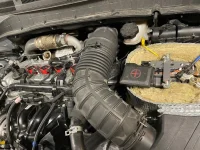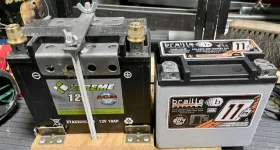TPPL Agms, when new and healthy and fully charged, will hold slightly higher voltages for longer under the same load and all other factors being equal, until the ~35% charged range/65% discharged.
When healthy TPPL AGMS are depleted this low, they can and will accept HUGE charging currents, I've fed my group 27 and group 31 Northstar AGMS in Excess of 135 amps, when they were new and healthy. They can be returned to 80% state of charge/20% depth of discharge, faster than any other lead acid battery, when newish and healthy.
ALL lead acid batteries take many hours to get from 80% to 100%. When new and healthy TPPL AGms are about 3 to 3.5 hours held at 14.4ish, and lesser AGMS and flooded add about 0.5 hours to it
The same size budget AGM, Flooded battery will take much less amperage to be brought to and held at 14.5 volts. When the charger amperage ilimited to 20 amps there will be almost no difference, but when it can suply 65 amps the TPPL AGm will be like a pig in feces, the regular AGM not so much and the flooded even less so.
So alternator free vehicular use, one must need to know how much amperage the battery needs to supply, and for how long it needs to supply it, in order to size the battery correctly. No need for a 78lb group 31 if one can get away with a ~54lb group 24, or even less.
When not in use, between runs, the well discharged AGM should be high amp recharged from their most depleted state. TPPL AGMS despise the low and slow from a well depleted state, especially if low and slow does not have enough time to get them 85%+, and ideally 100%, before the next discharge.
All lead acid batteries when new and healthy can output huge amps and accept huge amps when well depleted and attached to a high amperage charging source seeking and HOLDING, 14.4v for as long as is required for amps to taper to very low levels
The TPPL AGMS release their juice faster, maintaining higher voltage, and can recharge from below 80% charged to 80% charged significantly faster than other lead acid batteries. This is where they shine.
but there is little advantage in the 80% to 100% charged range, time wise, and if the TPPL AGM does not get the true 100% regularly, they will quickly lose their new healthy initial advantage.
On order to keep them performing well in deep cycle duty, they should be fed no less than 40 amps per 100Ah of capacity, and should be held at charging voltages until amps taper to very very low levels, unless they get too hot, then stop wait till they cool and then again hold at absorption voltage.
The TPPL Agms like Northstar/X2power and Odyssey can be the top performing lead acid battery one can get, but they are not immune to abuse and their performance advantages can degrade to make them no more impressive than the cheaper battery replaced more often.
Since Northstar no longer makes batteries for automotive applications, I assume Batteries plus is rebranding Odyssey as their X2 power lineup?
Does anybody know the new arrangement regarding X2power/batteries plus?
Anyway, if one is going to run a TPPL AGM, say in between 1/4 mile runs, or similar use, they would be wise to get a charge capable of 60+ amps.
These RV converters are automatic three stage chargers/power supplies, but user override selectable stages/voltages.
https://www.amazon.com/Progressive-Dynamics-PD9260CV-Inteli-Power-Converter/dp/B000GASX9O
Cut a pair of quality 4awg jumper cables in half, and one can have 55-60 amps available for fast recharges.
It will blow away any 'garage charger', and if the 55 to 60 amp potential is not needed/wanted. force it into a lower pressure (voltage) stage by holding the button for a few seconds.
The PD9260 has 60 amps available to seek and hold 14.4, 13.6, or 13.2v. 13.2v is too low for long term float of tppl AGMS at 77f, but if no parasitic load is on battery, force 14.4v for 4 hours, 13.6 for 12 hours and a month later they will still be 99.5%+ charged and happy and live a long life.
I put a PD9245 ( 40 amps max) in a power pack in 2015, chargibg a lifeline GPL-31XT( 125 amp hour) group 31 AGM battery.
The owner uses it to power an ARB fridge and lot of other things. To my surprise he claims battery is 'still strong like bull'
My instructions are to just plug it in for 12 to 16 hours when he gets home and for an hour once a month if not in use.


